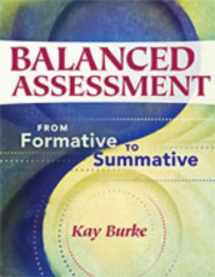
Balanced Assessment: From Formative to Summative
ISBN-13:
9781935249245
ISBN-10:
193524924X
Edition:
Illustrated
Author:
Kay Burke
Publication date:
2010
Publisher:
Solution Tree
Format:
Hardcover
163 pages
FREE US shipping
Book details
ISBN-13:
9781935249245
ISBN-10:
193524924X
Edition:
Illustrated
Author:
Kay Burke
Publication date:
2010
Publisher:
Solution Tree
Format:
Hardcover
163 pages
Summary
Balanced Assessment: From Formative to Summative (ISBN-13: 9781935249245 and ISBN-10: 193524924X), written by authors
Kay Burke, was published by Solution Tree in 2010.
With an overall rating of 4.5 stars, it's a notable title among other
books. You can easily purchase or rent Balanced Assessment: From Formative to Summative (Hardcover) from BooksRun,
along with many other new and used
books
and textbooks.
And, if you're looking to sell your copy, our current buyback offer is $0.32.
Description
Today, standards what students must know and be able to do are the starting point for all curriculum and instruction. In Balanced Assessment, Kay Burke shows teachers how to begin with the end in mind to start with the expectations for student achievement and then work backward from them to help all students succeed. She explains a process of analyzing the standards, deciding precisely what knowledge and skills will have to be taught and assessed, and then planning instruction to prepare students to demonstrate that they have met or exceeded the standards. Balanced assessment means integrating both formative and summative assessments seamlessly into instruction. This book makes clear that the distinction between the two types of assessment is not as rigid as many people believe. In fact, Dr. Burke explains that the very same assessment can be both formative and summative, depending on when it is administered and the purpose for which it is used. Formative assessments are administered frequently during a learning segment to provide feedback to both teachers and students about concepts and skills that students are having difficulty understanding or mastering. This feedback helps teachers modify and differentiate their instruction to help all students meet the standard. Summative assessments are administered at the end of a learning segment and are the final opportunity for students to demonstrate proficiency. Not all summative assessments are, as is often assumed, high-stakes state tests. Most are teacher created. Because each grade level or content area can have hundreds of standards, the best approach is for teachers to work together in teams to plan instruction and develop common assessments. The author describes the process teacher teams use to analyze the standards, develop engaging performance tasks that address the standards, and create two extremely versatile tools to assess student performance: checklists and rubrics. Both tools serve a dual function. They break down a process or task, such as writing a persuasive essay, into manageable steps for students to follow, and they provide feedback about a student s progress. Checklists reveal what students have yet to accomplish to complete a task; rubrics, which give more detailed descriptions of levels of performance, show what they need to do to improve the quality of their work. Perhaps most significantly, both tools can help students assess their own performance and direct their own learning.


We would LOVE it if you could help us and other readers by reviewing the book
Book review

Congratulations! We have received your book review.
{user}
{createdAt}
by {truncated_author}


